Physical Address
304 North Cardinal St.
Dorchester Center, MA 02124
Over the past several decades, endoscopy has become an integral tool for diagnosing inflammatory bowel disease (IBD), including ulcerative colitis (UC) and Crohn's disease (CD), and staging disease activity. Both CD and UC are characterized by the presence of intestinal inflammatory changes and ulcerations, which are detected during an endoscopic evaluation and confirmed by histopathology examination of specimens obtained during endoscopy. However, the endoscopic evaluation of IBD includes not only diagnosing the disease, assessing the disease's extent, and staging its activity, but also monitoring the responses to various medical therapies (with mucosal healing serving as a predictor of disease course) and managing the disease's complications. Several endoscopic scoring systems have been utilized for assessing and staging disease activity, thus allowing estimates of the prognosis and efficacy of medical treatment in IBD patients.
Current endoscopic modalities utilize not only high-definition endoscopes, but can also apply wide-field techniques such as chromoendoscopy (both dye-based and electronic based techniques) and, in some centers, small-field technologies such as confocal laser endomicroscopy (CLE) and endocytoscopy (EC), which facilitates our ability to not only detect but also to further characterize mucosal abnormalities and image ongoing physiologic processes in vivo. These newer endoscopic imaging technologies may not only further improve detection and characterization of mucosal lesions, but also may have the potential to assess severity, disease extent, and response to treatment in patients with IBD.
Other endoscopic imaging tools, such as wireless video capsule endoscopy (VCE) and balloon-assisted enteroscopy, also include enhanced imaging of the small bowel (SB) in the setting of CD.
In this chapter, we review the most recent advances of endoscopic evaluation in the diagnosis and staging of IBD, and ultimately the role of endoscopy in the effective care of patients with IBD.
Colonoscopy with endoscopic evaluation of the colon and distal ileum with biopsy is required in all patients who are clinically suspected of having IBD to effectively diagnose, stage disease activity and severity, and differentiate between UC and CD or other inflammatory entities such as ischemic colitis, infectious colitis, and diverticular-associated colitis. Based on various studies, colonoscopy with histopathology can accurately diagnose CD versus UC in 90% of patients. Endoscopic features such as rectal sparing, the presence of skip lesions, terminal ileal involvement, fistulas, and strictures can be seen in CD ( Figs. 38.1–38.3 ), whereas endoscopic features such as diffuse inflammatory changes with superficial ulcerations are suggestive of UC ( Fig. 38.4 ). However, these endoscopic features are not specific to either CD or UC ( – ). Histopathology examination based on biopsies obtained from both normal-appearing mucosa and abnormal mucosa is an integral component of endoscopic evaluation in patients suspected to have IBD. Specific histologic features associated with chronic inflammation will permit differentiation of IBD from other colitides such as infectious colitis, segmental colitis associated with diverticulosis, and ischemic colitis. However, the diagnosis of CD based on endoscopic evaluation with histopathology assessment may still be challenging. Patients with a colonic presentation of IBD in whom the disease cannot be classified as UC or CD colitis are determined to have an unclassified type of IBD (IBD-U) ( Fig. 38.5 ).
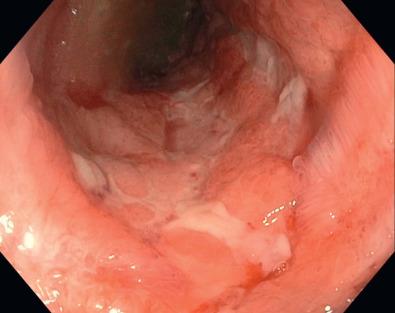
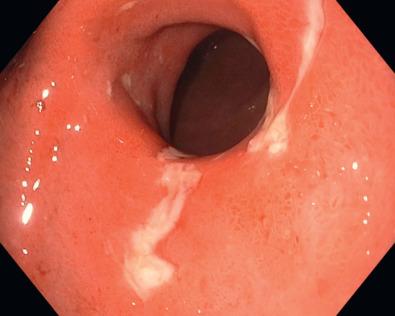
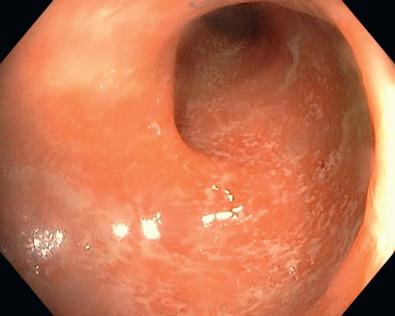
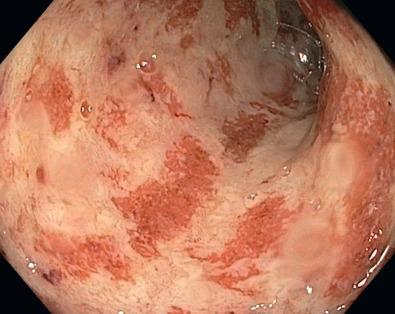
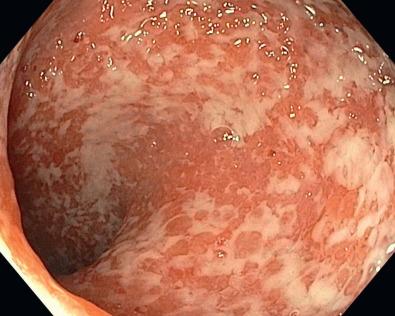
Patients with CD may present with continuous rectal inflammation involving the whole rectum and extending more proximally without the presence of skip areas, deep ulcerations, and certain histologic features such as the presence of granulomas on histopathology examination. In fact, some patients with CD may still have colonoscopy examinations with biopsies, which cannot differentiate from that of UC. These patients with continuous inflammation beginning in the rectum and extending more proximally may be thus erroneously classified as having UC without further evaluation of the terminal ileum (TI). Thus, additional endoscopic evaluation of the TI during each colonoscopy examination is required to establish an appropriate diagnosis of IBD ( Fig. 38.6 ). It may permit differentiation of UC from CD and further characterization of the subtypes of ileitis, specifically, CD ileitis and backwash ileitis. Backwash ileitis is typically a short segment of mildly inflamed mucosa of TI in the setting of existing colitis extending from the cecum without further progression to ulcerations, stenosis, and structuring. Colonic pseudopolyps are usually seen in patients with UC, as the repeated cycle of ulceration and deposition of granulation tissue during the healing phase results in the development of inflammatory polyps ( Fig. 38.7 ).
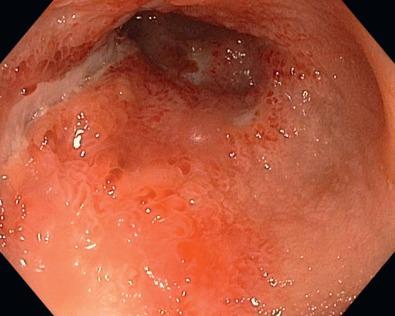
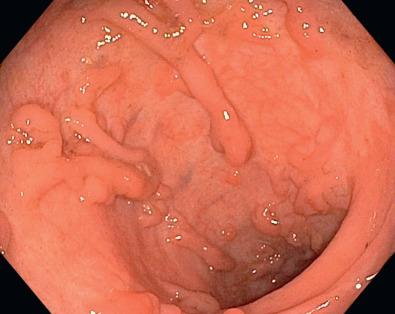
Diagnosing CD with SB involvement may be particularly challenging. The presence of SB involvement can be confirmed in approximately 80% of patients with CD, including one-third of all cases with CD presenting with only isolated SB disease. The most frequently encountered SB mucosal abnormalities suggestive of IBD include erosions, ulcers, erythema, villous blunting, and strictures, although they are not pathognomonic for CD as they can be seen in other conditions mimicking IBD. Table 38.1 summarizes frequent findings in IBD patients based on an endoscopic and histopathological evaluation.
| Disease | Colonoscopy With Ileoscopy | Esophagogastroduodenoscopy | Capsule Endoscopy | Histopathology |
|---|---|---|---|---|
| Ulcerative colitis | Rectum involved with continuous inflammatory changes and evident demarcation between normal and abnormal mucosa:
|
Normal esophagus, stomach, and duodenum | Normal-appearing small bowel, with the exception of backwash ileitis | Disported crypt architecture Abscesses Goblet cells decrease Basal plasmacytosis Paneth cell metaplasia |
| Crohn's disease | Inflammatory changes either limited to the rectum, left colon, right colon, or diffuse May also extend to the ileum Segmental involvement; subtle and or serpingous ulcers Cobblestoning Further features that can be present or absent:
|
Inflammatory changes in the duodenum, edema, erythema, erosions, ulcers with thickened folds, friable mucosa Duodenal strictures Pyloric stricture |
Mucosal abnormalities, erythema edema, erosions, ulcers | Distorted crypt architecture Occasional abscess Patchy distribution Non-caseating granulomas |
VCE is another endoscopic tool that enables noninvasive visualization of the entire SB mucosa and is utilized in patients with suspected CD and established IBD, allowing the assessment of encountered SB mucosa abnormalities (see Figs. 14.4 and 17.5 , as well as and ). Capsule endoscopy (CE) has been found to be more beneficial compared with push enteroscopy or radiologic imaging such as small bowel follow-through and computed tomography enterography in the evaluation of patients with known CD. The absence of typical capsule endoscopy features has a negative predictive value ranging from 96% to 100% based on available studies.
VCE plays a role in re-evaluating patients with diagnosed UC when there is a question of a potential misclassification or potential misdiagnosis, as there are also certain conditions in which appearances can mimic CD-related changes, including nonsteroidal antiinflammatory drug (NSAID)-related injuries, ischemia, radiation enteritis, and drug-induced enteritis. Mehdizadeh et al (2008) confirmed that 15% of a total of 120 patients with UC were found to have CD based on the CE findings.
Further SB visualization can be achieved with device-assisted enteroscopy such as single-balloon and double-balloon enteroscopy (DBE), as well as push enteroscopy. The diagnostic yield of balloon-assisted enteroscopy has been reported to be up to 59%. Mensink et al (2010) demonstrated that DBE evaluation was deemed to change clinical management in 74% of patients with CD with SB involvement, as well as facilitate achievement of clinical remission in 88%.
Based on a meta-analysis, the diagnostic yield of both VCE and DBE is comparable; however, VCE is still favored for the initial diagnostic approach as it is considered to be a noninvasive tool.
In the pediatric population, upper endoscopy (esophagogastroduodenoscopy [EGD]) is routinely performed when suspecting IBD, given the incidence of macroscopic involvement of the upper gastrointestinal tract reported to be as high as 30%, as well as the presence of microscopic changes seen in up to 60%. This approach is supported by guidelines introduced by the European Crohn's and Colitis Organization (ECCO) recommending EGD for all pediatric patients suspected of having IBD, but it is not recommended routinely in adult populations.
CD and UC can be classified based on endoscopic evaluation of disease location, maximal endoscopic involvement, and endoscopic presentation such as stricturing, penetrating versus nonstricturing, and nonpenetrating disease. This classification is known as the revised Montreal classification and is highlighted in detail in Table 38.2 .
| Ulcerative Colitis (UC) | UC Definition | Endoscopic Involvement |
|---|---|---|
| E1 E2 E3 |
Proctitis Left-sided colitis Extensive colitis |
Rectum Distal to splenic flexure Proximal to splenic flexure |
| Crohn's Disease (CD) | CD Location | CD Behavior |
| A1 ≤ 16 years A2 = 17–40 years A4 > 40 years |
L1: Ileal L2: Colonic L3: Ileocolonic L4: isolated upper GI |
B1: non-stricturing, nonpenetrating B2: stricturing B3: penetrating +p: perianal disease is present |
The lack of clearly visible endoscopic features of inflammation may not always correlate with histopathology assessment. Therefore, obtaining biopsies during endoscopic evaluation from various segments of the colon, including those with a normal endoscopic appearance, is necessary for the true assessment of disease extent in patients with suspected IBD.
Become a Clinical Tree membership for Full access and enjoy Unlimited articles
If you are a member. Log in here